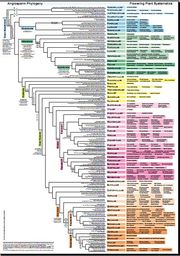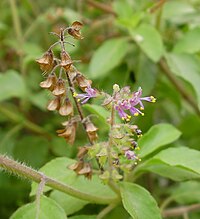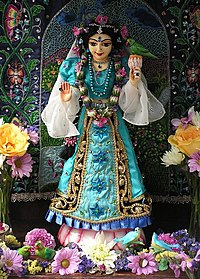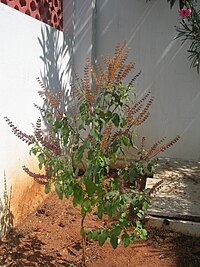Ocimum tenuiflorum
Read community contributed articles on biodiversity & environment || Cultural practices & mythological stories related to Indian biodiversity || Official documents related to environment || NGOs, Blogs and Websites || Environment-related video collection || Plants of India || Mammals of India || Facebook || Twitter
Share this page: Ocimum tenuiflorum
Ocimum tenuiflorum or Tulsi is one of the most sacred plants in Hinduism. The plant has several medicinal properties. It is found throughout India.
Click here to see all Semantic Properties associated with this page
Please note that the above slideshow is automatically created by searching Flickr and does not contain manually curated images. Hence, it is likely that some images may not be exactly of Ocimum tenuiflorum.
Click on the tabs below to know more...
- Species identity and nomenclature
- Current Wikipedia entry
- Binomial Classification
- Morphological features
- Habitat and Geographical Spread
- Maps
- Medicinal Importance
- Cultural significance
- Commercial importance and cultivation
- Summary of PubMed articles
- Summary of NCBI molecular data
- External Links
- Images and Videos
| Parameter | Value(s) | References See complete references in the References section at the end |
|---|---|---|
| Names of users who have contributed to this species page | Gauravm, Manasiapte | |
| Date on which this page was first created | 2010/06/07 | |
| This page was last modified on: | 24 November 2010 03:59:20 | |
| Name of the species | Ocimum tenuiflorum | |
| ID on Encyclopedia of Life | 480298 | |
| Synonyms | Please check Binomial Classification section for synonyms. | |
| Common English Names | Holy Basil, Indian Basil | |
| Common Hindi Names | तुलसी Tulsi | |
| Common Indian names | तुलसी Tulsi (Hindi); तुळस Tulas (Marathi); तुलसी Tulasi (Assamese); Tulasi (Bengali); Thulasi (Kannada); Thulasi (Tamil); Tulasi (Telugu); Brynda (Telugu); Gaappaara Chettu (Telugu) | FoI |
| Origins/Meanings of the common names |
Taxonomy from Encyclopedia of Life
If nothing is displayed in this section, it means the EoL ID has not been defined. Please click on Edit with form button on top and follow the instructions for filling in the EoL ID
{{#EoLOnlyHierarchy:480298}}
Taxonomy filled in form

Click here for the PDF of the phylogeny
| Taxon | Value |
|---|---|
| Regnum (Kingdom) | Plantae |
| Division | Angiosperms (Unranked) |
| Class | Eudicots (Unranked) |
| Order | Lamiales |
| Family | Lamiaceae |
| Genus | Ocimum |
| Source of data | ' |
|
|
| ||||||||||||||||||||
| Order | Taxon details | Taxon morphology details |
|---|---|---|
| Lamiales | Species in this order probably arose ~70-100 million years ago based on various estimates. Lamiales contain ~12% of eudicot diversity. Well-known or economically important members of this order include lavender, lilac, olive, jasmine, the ash tree, teak, snapdragon, sesame, psyllium, and a number of table herbs such as mint, basil, and rosemary. | Members of this species are herbaceous or shrubby, have mono-symmetric flowers and numerous small seeds. Species in this order typically have the following characteristics, although there are exceptions to all of them - 1) superior ovary composed of two fused carpels 2) five petals fused into a tube 3) bilaterally symmetrical, often bilabiate corollas and 4) four (or fewer) fertile stamens |
|
|
Based on classification
More details can be found in the Binomial Classification section.
Morphology from Encyclopedia of Life
If nothing is displayed in this section, it means the EoL ID has not been defined. Please click on Edit with form button on top and follow the instructions for filling in the EoL ID
{{#EoLOnlyDescription:480298}}
General morphology
| Parameter | Value(s) | References See complete references in the References section at the end |
|---|---|---|
| General morphological features of the plant |
| Seed dispersal mechanism | ||
|---|---|---|
| Bloom type | Annual, Perennial | HimalayaHealth, USDA |
| Life cycle of the plant |
How to identify this species
For a detailed description, refer to the General Morphology details above
| Parameter | Value(s) | References See complete references in the References section at the end |
|---|---|---|
| Type of plant | Herb | |
| Plant height | ||
| Flower color | Lavender/Purple | Wiki |
| Flower shape | ||
| Floral symmetry | ||
| Phyllotaxy of leaves | ||
| Leaf shape | ||
| Is the leaf petiolated or sessile? | ||
| Is the leaf simple or compound? |
| Parameter | Value(s) | References See complete references in the References section at the end |
|---|---|---|
| IUCN Conservation Status | Not Evaluated | EoL |
| Indian States in which the species has been documented | Assam,Andhra Pradesh,Andaman and Nicobar Islands,Bihar,Goa,Gujarat,Haryana,Himachal Pradesh,Jammu and Kashmir,Jharkhand,Karnataka,Kerala,Madhya Pradesh,Maharashtra,Orissa,Punjab,Rajasthan,Tamil Nadu,Tripura,Uttarakhand,Uttar Pradesh,West Bengal | HimalayaHealth |
| Locations at which the species has been documented | ||
| Biotic zones inhabited | Northeastern Himalayas, Northwestern Himalayas, Eastern Ghats, Western Ghats, Central Deccan Plateau, East Coast, West Coast, Indo-Gangetic Plain, Thar Desert and Rann of Kutchch, Outlying Islands | Based on HimalayaHealth |
| Details about the habitat | This plant is found all across India in a wide range of habitats. In the Himalayas, it is found upto 1800m altitude. Tulsi generally prefers moist soils. | HimalayaHealth |
| Is this species native to India? | Yes | Das SK |
| Is the species indigenous/endemic to Sub-Himalayan regions? | HimalayaHealth | |
| Is the species indigenous/endemic to Western Ghats? | HimalayaHealth | |
| Is the species indigenous/endemic to Eastern Ghats? | HimalayaHealth |
More plants native to India
| ||||||||||||||||||||||||||||||||||||||||||
If no maps are displayed below, it means the required data is absent. Click on "Edit with form" button on top of the page to add this information.
{{#generateMap:Assam,Andhra Pradesh,Andaman and Nicobar Islands,Bihar,Goa,Gujarat,Haryana,Himachal Pradesh,Jammu and Kashmir,Jharkhand,Karnataka,Kerala,Madhya Pradesh,Maharashtra,Orissa,Punjab,Rajasthan,Tamil Nadu,Tripura,Uttarakhand,Uttar Pradesh,West Bengal|Ocimum_tenuiflorum_brahma.svg|align=center}}
| Parameter | Value(s) | References See complete references in the References section at the end |
|---|---|---|
| Does this species have any medicinal use? | Yes |
|
Other plants of the same family having medicinal use:
|
| Parameter | Value(s) | References See complete references in the References section at the end |
|---|---|---|
| General types of ailments this species is used for treating | Infectious diseases, Pains and Inflammation, Systemic disorders, Organ-specific disorders | |
| Specific ailments for which the species is used | Common cold, Headaches, Stomach disorders, Inflammation, Heart disease, Poisoning, Malaria | Wiki |
| Medicinal systems which use this plant | Ayurveda, Folk Medicine, Modern Medicine | HimalayaHealth,Self |
| Details of Medicinal use | High content of secondary metabolites in leaves makes it suitable for treatment of several conditions. 90% ethanol extract of leaves has been shown to be hepato-protective in rats. Oral administration of this extract lowers blood sugar level in rats. Some of the main constituents of Tulsi are Oleanolic acid, Ursolic acid, Rosmarinic acid, Eugenol, Carvacrol, Linalool, and β-caryophyllene which can have anti-histaminic, anti-pyretic properties.
In traditional medicine, aqueous extract of Tulsi leaves is used for common colds and fever . Tulsi powder is also used for treating jaundice and for alleviating blood pressure. |
HimalayaHealth,Wiki |
| Parts of the plant used for treatment | Leaves, Seeds | Himalaya Health |
| Names of some medicinal active compounds in this plant, if known. | ||
| Details of the active chemical compounds found in this plant | ||
| Is the molecular basis of the medicinal action known? | ||
| Details of molecular basis of action | ||
| Are the toxic effects of consumption of this plant known? | Yes | Himalaya Health |
| Details of the toxic effects of the plant species | LD50 of the leaf extract in mice is 3.75g/kg, when provided intra-peritoneally. | Himalaya Health |
| Have there been validation/clinical studies related to this plant? | Yes | Himalaya Health |
| Details of the clinical studies related to the plant species | In one clinical study from 1983, it was found that in patients suffering from viral encephalitis, the aqueous extract of leaves led to higher survival rate than steroid-treated patients. The incidence of neurological deficit was also found to be low in treated patients. | Himalaya Health |
| Parameter | Value(s) | References See complete references in the References section at the end |
|---|---|---|
| Is this plant/plant-derived product used in food preparations? | Yes | User-reported |
| Part(s) of the plant used in the food preparations | Leaves | |
| Details of use in food preparations | ||
| Does this species have any religious significance? | Yes | User-reported |
| Religions which mention/give significance to this species | Hinduism | |
| Religious occasions | ||
| Details of religious use | Tulsi, which is Sanskrit for "the incomparable one", is worshiped throughout India, most often regarded as a consort of Vishnu in the form of Mahalakshmi. There are two types of Tulsi worshiped in Hinduism—"Rama Tulsi" has light green leaves and is larger in size; "Krishna Tulsi" has dark green leaves and is important for the worship of Vishnu. Many Hindus have tulsi plants growing in front of or near their home, often in special Tulsi pots. It is also frequently grown next to Vishnu temples, especially in Varanasi.
In the ceremony of Tulsi Vivah, Tulsi is ceremonially married to Vishnu annually on the eleventh bright day or twelfth of the month of Kartika in the lunisolar calendar. That day also marks the end of the four month cāturmāsya period, which is considered inauspicious for weddings and other rituals, and so the day inaugurates the annual marriage season in India. The ritual lighting of lamps each evening during Kartika includes the worship of the Tulsi plant, which is considered auspicious for the home. Vaishnavas especially follow the daily worship of Tulsi during Kartika. Vaishnavas traditionally use japa malas made from tulsi stems or roots, which are an important symbol of initiation. Tulsi malas are considered to be auspicious for the wearer, and believed to put them under the protection of Vishnu or Krishna. They have such a strong association with Vaishnavas, that followers of Vishnu have long been called "those who bear the tulasi round the neck". |
Wiki |
| Parameter | Value(s) | References See complete references in the References section at the end |
|---|---|---|
| Is this plant cultivated commercially in India? | Yes | Gauravm |
| Uses for which the plant is commercially cultivated | Human consumption, Medicinal use, Ornamental use, Religious use | Gauravm |
| Plant parts of commercial value | Bark, Leaves | Gauravm |
| Products where this plant is used | User-reported | |
| Description of use | ||
| States where this plant is cultivated commercially | ||
| Best period for planting this plant | ||
| Best period for harvesting this plant | ||
| Method of propagation | Seeds | |
| Water requirement of this plant | Average | Gauravm |
| Pests and Diseases affecting this plant during cultivation | ||
| Other considerations while cultivating this plant |
Pubmed Word cloud
This word cloud is obtained using the tool LigerCat by searching the Pubmed database. LigerCat builds the cloud from the most relevant Medical Subject Headings (MeSH) terms. Each term's relative size indicates how many times it appears in the PubMed search results. Click on a term to access the full LigerCat cloud, with live PubMed search capabilities. LigerCat has been developed for the Biology of Aging Project.
The page may take some time to load since LigerCat is searching the entire PubMed database and sending us the results in real time.
- If there is an error message below, it means that there is no retrievable information available on NCBI
- If the number of nucleotide sequences is less than 100, very little genomic work has been done on this species. A respectable number of nucleotide sequences is above 10000.
- Most of the nucleotide sequences may come from three sources:
- Studies on single genes, where people try to sequence genes such as some specific dehydrogenases important,say, for tannin production
- Sequences of Ribosomal Internal Transcribed Spacer, whose sequence is used for generating molecular phylogenetic trees to establish species relationships
- Expressed Sequence Tags (ESTs) which can tell about which genes are present and expressed in the species at a particular time in the given tissue
{{#queryDB:taxonomy |Ocimum tenuiflorum }}
| Parameter | Value(s) | References See complete references in the References section at the end |
|---|---|---|
| Details of modern scientific knowledge available for this species | ||
| Are herbarium specimen available for this species? | ||
| Institutes having herbarium samples |
If nothing is displayed in this section, it means the EoL ID has not been defined. Please click on Edit with form button on top and follow the instructions for filling in the EoL ID
{{#EoLOnlyAdditionalInfo:480298}}
Click here to go to Google Images
| File:Japamala2.jpg A sacred bead thread (Japamala) made from Tulsi wood |
References
Das SK (Journal) : Das, SK (Aug 2006),Tulsi: The Indian holy power plant, Indian Journal of Natural Products and Resources (IJNPR):5(4):279. doi=NA
HimalayaHealth (Web): Herbal Monograph:Ocimum, Accessdate=2010-06-19
EoL (Web): Encylopedia of Life entry on Ocimum tenuiflorum, Accessdate=2010-06-20
Wiki (Web): Wikipedia entry on Ocimum tenuiflorum, Accessdate=2010-06-20
USDA (Web): Plants profile for Ocimum tenuiflorum, Accessdate=2010-06-21
ENVIS (Web): ENVIS Centre on Medicinal Plants, Accessdate=2010-06-21
| This article is a stub. You can help Project Brahma by expanding it. |



